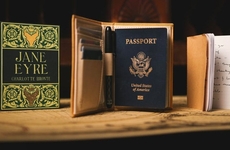
These Lesbian Pulp Novels Provide a Potral into a Bygone Era
Jordan Sowunmi — July 5, 2011 — Lifestyle
References: beinecke.library.yale.edu & howtobearetronaut
The Beinecke Library at Yale University is home to an extensive collection of lesbian pulp novels spanning 1935-1958, and the covers of the novels are a veritable must see for any fan of pulp fiction or historical pop (and sub) culture.
Lesbian pulp novels were a staple of newsstands, airports, bus terminals and drug stores in the early to mid-1900s. Many pulp fiction novels (including some of these lesbian pulp fiction novels), were written by established literature writers under pseduonyms authors Gore Vidal (pen names: Edgar Box, Cameron Kay, and Katherine Everard), Stephen King (pen name: Richard Bachmann), mystery writer Lawrence Block (pen names: Jill Emerson, Sheldon Ward, Andrew Shaw), and Marion Zimmer Bradley (pen names: Lee Chapman, Miriam Gardner, and Morgan Ives).
These lesbian pulp novels are currently on display in the Beinecke Library at Yale University.
Lesbian pulp novels were a staple of newsstands, airports, bus terminals and drug stores in the early to mid-1900s. Many pulp fiction novels (including some of these lesbian pulp fiction novels), were written by established literature writers under pseduonyms authors Gore Vidal (pen names: Edgar Box, Cameron Kay, and Katherine Everard), Stephen King (pen name: Richard Bachmann), mystery writer Lawrence Block (pen names: Jill Emerson, Sheldon Ward, Andrew Shaw), and Marion Zimmer Bradley (pen names: Lee Chapman, Miriam Gardner, and Morgan Ives).
These lesbian pulp novels are currently on display in the Beinecke Library at Yale University.
Trend Themes
1. Rise of Pulp Fiction - The resurgence of pulp fiction novels presents an opportunity for new authors to tap into a nostalgic market and reinvent the genre.
2. Representation in Literature - There is a growing demand for diverse and inclusive storytelling, providing an opportunity for authors to explore themes of LGBTQ+ representation in their work.
3. Archiving Historical Fiction - Libraries and institutions can take advantage of preserving and displaying historical fiction to educate and engage audiences about different eras in literature.
Industry Implications
1. Publishing - Publishers can capitalize on the popularity of pulp fiction by releasing new titles in this genre, attracting nostalgic readers and fans of vintage aesthetics.
2. Libraries and Museums - Libraries and museums can curate exhibitions featuring historical fiction, like these lesbian pulp novels, to offer a unique experience for visitors and showcase literary diversity.
3. Film and Television - The captivating narratives and unique visual aesthetics of pulp fiction novels provide a rich source of inspiration for filmmakers and TV producers seeking fresh content ideas.
6.4
Score
Popularity
Activity
Freshness























